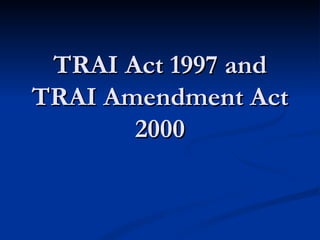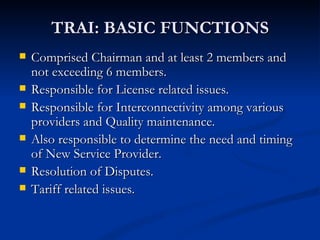TRAI
- 1. TRAI Act 1997 and TRAI Amendment Act 2000
- 2. Why TRAI was formed NTP 1994 ŌĆō DoT was the policy maker and competitor to private entrants. Private enterprises were discouraged to enter the telecom market. Rural telecommunications suffered the most. 1997 ŌĆō TRAI was formed as an independent authority. To regulate and provide guiding principles to service providers. To ensure the interests of consumers of Telecom services.
- 3. TRAI: BASIC FUNCTIONS Comprised Chairman and at least 2 members and not exceeding 6 members. Responsible for License related issues. Responsible for Interconnectivity among various providers and Quality maintenance. Also responsible to determine the need and timing of New Service Provider. Resolution of Disputes. Tariff related issues.
- 4. Why amendment act 2000 1998 ŌĆō DoT filed a lawsuit against TRAI and decision was in favor of DoT. It was apparent that DoT could still control policy-making. 1999 ŌĆō NTP without representation from TRAI or DoT. Only recommendations were sought. 2000 ŌĆō Govt realized that TRAI had to be reconstituted with more independence. Amendment act made it an advisory body whose recommendation would be non-abiding by the govt. TDSAT was formed to adjudicate disputes.
- 5. TRAI ACT (AMENDMENT) 2000 Comprised Chairman & not more than 2 whole time members & 2 part time members. Terms and Qualification of Chairman and members revised. Functions amended. Disputes handling was given to TDSAT. Amendment was quite extensive .
- 6. Recent Regulations Telecommunication Tariff Order, 2010 Promotion of Digital Addressable systems to improve the quality of service to the consumers Applicable to all digital addressable systems such as DTH, HITS, IPTV, and digital addressable Cable TV Service Provider mandated to provide pay channels on la carte basis till Jan 2011 The service providers have to publish the channel rates every three months (minimum 150 Rs)
- 7. Recent Regulations ContinuedŌĆ” Revisit of guidelines for Uplinking/Downlinking Policy 2005 Permission Period (10 Years) No cap be placed on the number of satellite broadcasting channels in India Minimum 10 Years Work Experience at Top Level Management at reputed firm a prerequisite
- 8. Fee Applicable Content Wise Net Worth for First Channel (Cr) Net Worth for Subsequent Channel (Cr) News Channel 100 25 Non-News Channel 25 10 Education Channels N.A. N.A. Kids Channel 5 N.A.
- 9. FCC-Federal Communications Commission Started in 1934 Regulates interstate and international communications by radio, television, wire, satellite and cable Works towards six goals-Broadband, communication, spectrum, media, public safety and homeland security Works on improving the Communications throughout US Consists of 7 Bureaus: Consumer and Governmental Affairs, Enforcement Bureau , International Bureau, Media Bureau, Wireless Telecommunications Services, Wireline Competition Bureau, Public Safety and Homeland Security Bureau









